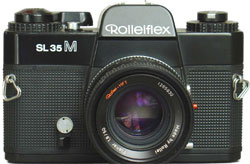
Lens Mount: Rollei bayonet
Batteries: 1.3V PX625
Approx. dates of manufacture: 1976-1980
Approx. original price: $120
Approx. street value: moderate, if you can find one that works
When I was still in college, one day I was looking at the consignment shelf at a (no longer in business) camera shop and I saw a Rolleiflex SL35M, with a 50mm lens, for $10. It was jammed. I bought it, and as I drove home my father, who's very good with all things mechanical, was fiddling with it, and somehow cleared the jam. (It never jammed again for me.)
I think it's a beautiful camera. The styling of this and particularly the SL35E lead the field at the time. Rollei always seemed to know how to make cameras beautiful, even if I couldn't get beautiful photos out of them.
s.jpg) I had it for probably 10 years. I often carried it as my backup camera, in the days when I had an AE-1, a backup camera, and a Kodak Stereo in my huge Domke photojournalist bag; back when I wanted to look like Dennis Hopper in Apocalypse Now. I took it to Hawaii on a vacation but never got anything memorable out of it. It's not really the camera's fault, it was me, but I still associate it with disappointment.
I had it for probably 10 years. I often carried it as my backup camera, in the days when I had an AE-1, a backup camera, and a Kodak Stereo in my huge Domke photojournalist bag; back when I wanted to look like Dennis Hopper in Apocalypse Now. I took it to Hawaii on a vacation but never got anything memorable out of it. It's not really the camera's fault, it was me, but I still associate it with disappointment.
Sold it to someone who loved it, but I never really felt right about selling it. I'm a collector and I had no other Rolleis at the time. But there it is. I ended up getting another one, also broken but this one unrepairable (needs a planetary gear in the winding mechanism, I was told); so I've got another shelf queen.
Interesting story behind this camera. The Japanese are currently doing in the car market what they were doing with cameras back in the 60s and 70s: they began with low-end, inexpensive cameras, and they gradually added quality and features but kept the prices competitive. So eventually you could save up awhile and buy a really nice Nikon or you could mortgage the house and buy a Leica; a lot of people went Japanese.
After killing off the American manufacturers, they went after the Germans. The ultra-premium makes like Leica and Hasselblad survived, but the others had a lot of trouble. Rollei, for instance, was under a terrific assault from all sides. Their bread-and-butter was the Rolleiflex TLR, and while that was still considered best-of-class, in professional medium-format they were competing against Hasselblad in Sweden, and the Japanese had Bronica and Pentax's 67; worse yet, the Japanese had pro-level TLRs from Minolta, Mamiya and Yashica. Even the Chinese were weighing in with their Seagulls.
So Rollei decided to expand their lineup, and entered the ferociously competetive 35mm format. At the high end they made the 3003, which looked incredible but cost a king's ransom; and at the low end they made a rangefinder called the Rollei 35. The latter was made in a factory in Singapore to keep costs down and make it competitive with the Japanese. But it was still pricey. In the middle they made a 35mm SLR called the SL35, which was nice and it had German quality and optics, but it wasn't exactly cheap either.
In 1972, Zeiss Ikon ceased making cameras. At the time Zeiss owned Voigtländer, which Rollei acquired. Among other things, it gave them the works for Voigtländer's new camera.
Rollei ended their SL35 line and decided to go with Voigtländer's design instead, which they manufactured in their Singapore plant. In 1976 they rolled out the new camera with dual badging and tweaks; the Voigtländer version was the VLS 1 and the Rollei version was the SL35M.
Nice camera, but it was killed (as were many others) by the Canon AE-1. against which its match-needle metering looked quaint. A version with an electro-magnetic shutter and an improved metering system, the SL35ME, didn't fare better.
In 1978, Rollei brought out a new version that had aperture-priority automatic, an in-viewfinder shutter-readout, and an accessory power-winder. This became the Voigtländer VLS 3-E and the Rollei SL35E.
But it was too little, too late. The cameras were expensive, heavy and under-featured compared to the Japanese offerings, particularly Canon's A series and the Olympus OM series. Plus the Singpore-produced cameras lacked the German-quality, so it was difficult to justify paying a premium simply for the Rollei name. In 1982 Rollei went bankrupt. The company survived but among the casulties were the Singapore factories, Voigtländer and the 35mm line.
Camera manual: Orphan Cameras.com
There's a very nice website on the Rolleiflex SL35 system.


